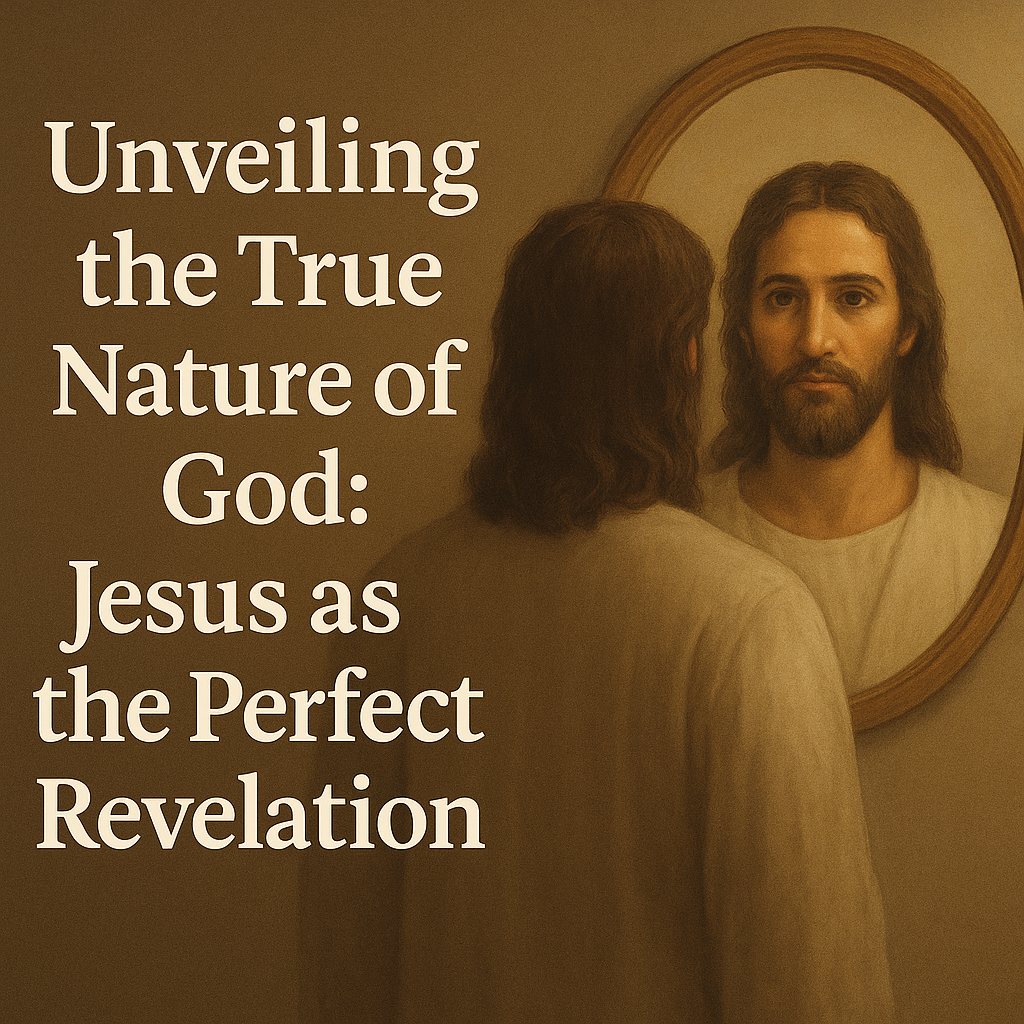Five Things We Will Learn
- Why many Christians misunderstand God the Father’s nature and how this distortion stems from a lack of context when interpreting Scripture.
- How Jesus’ life—not just His death—corrects our perspective of the Father, revealing God’s true character through compassion, grace, and relational love.
- Why the popular contrast between a harsh Father and kind Jesus contradicts Scripture, and how the unity between them unveils God’s consistent nature.
- How biblical stories like the woman caught in adultery and Abraham’s test of faith reveal God’s mercy, not wrath, when understood through Jesus.
- Why Jesus is the full and final revelation of God, far surpassing earlier partial revelations through Moses or the Law, and what that means for our faith.
In a world filled with diverse perceptions of divinity, many believers grapple with a distorted view of God the Father. Often portrayed as distant, critical, and judgmental, God seems starkly contrasted with the compassionate, approachable figure of Jesus. However, as shared in a profound discussion by worship leader and songwriter Joe L. Barnes—best known for co-writing the worship anthems “Promises” with Maverick City Music—and “Million Little Miracles” with Elevation worship —this misconception stems from a lack of context. By examining the life of Jesus—not just His death—we can correct this image, drawing on biblical scriptures that illuminate God’s true character. As Colossians 1:15 declares, “The Son is the image of the invisible God, the firstborn over all creation” (NIV). This article explores how Jesus serves as the ultimate revelation of the Father, supported by key biblical passages.
The Common Misconception: A Distorted View of the Father
One of the biggest misconceptions in faith today is the misinterpretation of God the Father’s perspective due to insufficient context. People often view God as critical, dictating, disappointed, and a judge from afar, while seeing Jesus as kind, approachable, very present, and close. This duality creates confusion, as if the Father and Son embody opposing natures. Yet, scripture challenges this divide. In Hebrews 1:3, we read, “The Son is the radiance of God’s glory and the exact representation of his being, sustaining all things by his powerful word” (NIV). This verse underscores that Jesus is not a softened version of God but His precise embodiment, urging us to reconsider our assumptions through biblical lens.
Barnes emphasizes that without proper context, we’ve misinterpreted God’s actions and character, leading to a blurred image. This echoes the broader biblical theme where human limitations obscure divine truth, as seen in 1 Corinthians 13:12: “For now we see only a reflection as in a mirror; then we shall see face to face” (NIV). The key to clarity lies in Jesus, who bridges this gap.
Beyond the Crucifixion: Jesus’ Life as the Fix for Our Vantage Point
We frequently hinge our understanding of Jesus on His death, blood, and crucifixion—a great place to start, but a terrible place to stop. His life was designed to fix our vantage point about the Father. Jesus’ existence on earth helps correct our perspective, as He Himself stated in John 14:9: “Anyone who has seen me has seen the Father. How can you say, ‘Show us the Father’?” (NIV). This direct claim from Jesus dismantles the idea of a harsh Father, revealing unity between the two.
Barnes points out that Jesus’ life demonstrates God’s heart, not just His sacrificial act. In John 1:18, scripture affirms, “No one has ever seen God, but the one and only Son, who is himself God and is in closest relationship with the Father, has made him known” (NIV). By focusing solely on the cross, we miss how Jesus’ teachings, miracles, and interactions paint a fuller picture of God’s compassionate nature, aligning with the Father’s will as described in the Old Testament prophecies like Isaiah 9:6, where the coming Messiah is called “Wonderful Counselor, Mighty God, Everlasting Father, Prince of Peace” (NIV).
Contradicting Views: Why the Father Can’t Be Distant If Jesus Is Close
The notion that God is a disappointed judge while Jesus is approachable creates a contradiction. Jesus lacks the license to say, “When you see me, you see the Father,” if these characterizations hold true—they’re too opposing. As Barnes notes, drawing from his apostle’s teachings, this split view doesn’t align with scripture. Philippians 2:6-7 reinforces Jesus’ divine equality: “Who, being in very nature God, did not consider equality with God something to be used to his own advantage; rather, he made himself nothing by taking the very nature of a servant” (NIV).
This unity is evident throughout the Gospels. In John 10:30, Jesus declares, “I and the Father are one” (NIV), emphasizing that His kindness reflects the Father’s heart. The misconception arises from selective reading, ignoring how Jesus embodies God’s full attributes, including justice and mercy, as prophesied in Micah 7:18: “Who is a God like you, who pardons sin and forgives the transgression of the remnant of his inheritance? You do not stay angry forever but delight to show mercy” (NIV).
The Woman Caught in Adultery: God’s Handling Through Jesus
To illustrate, consider the story of the woman caught in adultery in John 8:1-11. The Pharisees bring her to Jesus, citing the Law of Moses that demands stoning. They ask, “What do you say?” Jesus responds with wisdom: “Let any one of you who is without sin be the first to throw a stone at her” (John 8:7, NIV). One by one, they leave, and Jesus tells her, “Neither do I condemn you… Go now and leave your life of sin” (John 8:11, NIV).
Barnes urges us to “freeze the frame” here. Moses, under the old covenant, enforced the law, but Jesus reveals the Father’s grace. This moment shows how the Father would handle such a situation—not with distant judgment, but with mercy that leads to transformation, as echoed in Romans 2:4: “Or do you show contempt for the riches of his kindness, forbearance and patience, not realizing that God’s kindness is intended to lead you to repentance?” (NIV).
Shadow vs. Substance: Moses’ Limited View Compared to Jesus
Moses saw God through the cleft of a rock, glimpsing only His back, as described in Exodus 33:18-23: “Then the Lord said, ‘There is a place near me where you may stand on a rock. When my glory passes by, I will put you in a cleft in the rock and cover you with my hand until I have passed by. Then I will remove my hand and you will see my back; but my face must not be seen'” (NIV). This partial revelation contrasts with Jesus, the embodiment of God in the flesh—everything God has to say about Himself.
Barnes questions: Who has a better understanding of the Father’s handling—Moses, who saw a shadow, or Jesus, the full expression? Colossians 2:17 describes old covenant elements as “a shadow of the things that were to come; the reality, however, is found in Christ” (NIV). Jesus provides the complete picture, fulfilling the law with grace.
The Shadow Analogy: Everyday Illustrations of Partial vs. Full Knowledge
If someone saw only your shadow, they’d describe you as dark, skinny, and scary. But your wife, knowing your eyes, features, expressions, character, speech, and patience, offers a true understanding. Similarly, we’ve missed God’s way without context. Barnes uses this to highlight how shadows distort—much like how Job 10:16 portrays incomplete views leading to fear: “If I hold my head high, you stalk me like a lion and again display your awesome power against me” (NIV). Yet, in Christ, we see the full, loving Father, as 1 John 4:18 assures: “There is no fear in love. But perfect love drives out fear” (NIV).
Contextualizing Abraham’s Sacrifice: Not Bloodthirsty, But Loving
We thought God was bloodthirsty in Abraham’s story (Genesis 22), asking him to sacrifice Isaac. But context reveals Abraham’s Mesopotamian background, where 400 gods demanded child sacrifice for appeasement. God commands the act but intervenes: “Do not lay a hand on the boy… Now I know that you fear God, because you have not withheld from me your son, your only son” (Genesis 22:12, NIV). God declares, “If anyone’s going to sacrifice their son to prove love, it’s me—not you.”
This foreshadows John 3:16: “For God so loved the world that he gave his one and only Son, that whoever believes in him shall not perish but have eternal life” (NIV). No other god offers their son; God reconciles the world through Jesus on the cross (2 Corinthians 5:19), proving His unique love.
Correcting the Distorted Image: Embracing the Full Context
Without context, we’ve misinterpreted God’s image, seeing distortion where unity exists. Jesus corrects this, reconciling us to the Father. As Barnes concludes, the image was distorted, but through Christ, it’s restored. Ephesians 4:24 calls us to “put on the new self, created to be like God in true righteousness and holiness” (NIV). By studying Jesus’ life with scriptural context, we move from misconception to intimate knowledge of a loving Father. Let this revelation transform your faith—see the Father in the Son, and live in the light of His true character.




